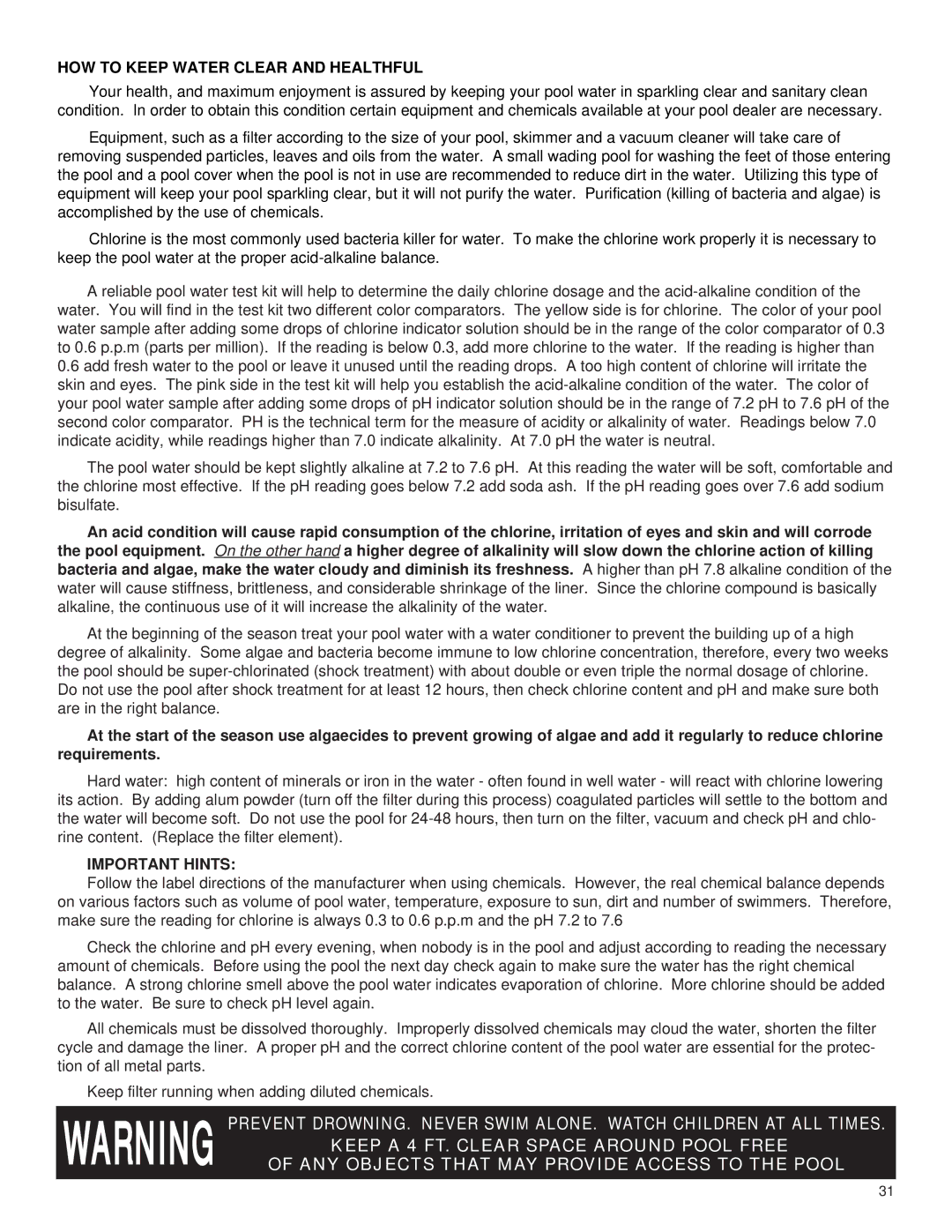
HOW TO KEEP WATER CLEAR AND HEALTHFUL
Your health, and maximum enjoyment is assured by keeping your pool water in sparkling clear and sanitary clean condition. In order to obtain this condition certain equipment and chemicals available at your pool dealer are necessary.
Equipment, such as a filter according to the size of your pool, skimmer and a vacuum cleaner will take care of removing suspended particles, leaves and oils from the water. A small wading pool for washing the feet of those entering the pool and a pool cover when the pool is not in use are recommended to reduce dirt in the water. Utilizing this type of equipment will keep your pool sparkling clear, but it will not purify the water. Purification (killing of bacteria and algae) is accomplished by the use of chemicals.
Chlorine is the most commonly used bacteria killer for water. To make the chlorine work properly it is necessary to keep the pool water at the proper
A reliable pool water test kit will help to determine the daily chlorine dosage and the
0.6add fresh water to the pool or leave it unused until the reading drops. A too high content of chlorine will irritate the skin and eyes. The pink side in the test kit will help you establish the
The pool water should be kept slightly alkaline at 7.2 to 7.6 pH. At this reading the water will be soft, comfortable and the chlorine most effective. If the pH reading goes below 7.2 add soda ash. If the pH reading goes over 7.6 add sodium bisulfate.
An acid condition will cause rapid consumption of the chlorine, irritation of eyes and skin and will corrode the pool equipment. On the other hand a higher degree of alkalinity will slow down the chlorine action of killing bacteria and algae, make the water cloudy and diminish its freshness. A higher than pH 7.8 alkaline condition of the water will cause stiffness, brittleness, and considerable shrinkage of the liner. Since the chlorine compound is basically alkaline, the continuous use of it will increase the alkalinity of the water.
At the beginning of the season treat your pool water with a water conditioner to prevent the building up of a high degree of alkalinity. Some algae and bacteria become immune to low chlorine concentration, therefore, every two weeks the pool should be
At the start of the season use algaecides to prevent growing of algae and add it regularly to reduce chlorine requirements.
Hard water: high content of minerals or iron in the water - often found in well water - will react with chlorine lowering its action. By adding alum powder (turn off the filter during this process) coagulated particles will settle to the bottom and the water will become soft. Do not use the pool for
IMPORTANT HINTS:
Follow the label directions of the manufacturer when using chemicals. However, the real chemical balance depends on various factors such as volume of pool water, temperature, exposure to sun, dirt and number of swimmers. Therefore, make sure the reading for chlorine is always 0.3 to 0.6 p.p.m and the pH 7.2 to 7.6
Check the chlorine and pH every evening, when nobody is in the pool and adjust according to reading the necessary amount of chemicals. Before using the pool the next day check again to make sure the water has the right chemical balance. A strong chlorine smell above the pool water indicates evaporation of chlorine. More chlorine should be added to the water. Be sure to check pH level again.
All chemicals must be dissolved thoroughly. Improperly dissolved chemicals may cloud the water, shorten the filter cycle and damage the liner. A proper pH and the correct chlorine content of the pool water are essential for the protec- tion of all metal parts.
Keep filter running when adding diluted chemicals.
WARNING PREVENT DROWNING. NEVER SWIM ALONE. WATCH CHILDREN AT ALL TIMES. KEEP A 4 FT. CLEAR SPACE AROUND POOL FREE
OF ANY OBJECTS THAT MAY PROVIDE ACCESS TO THE POOL
31
